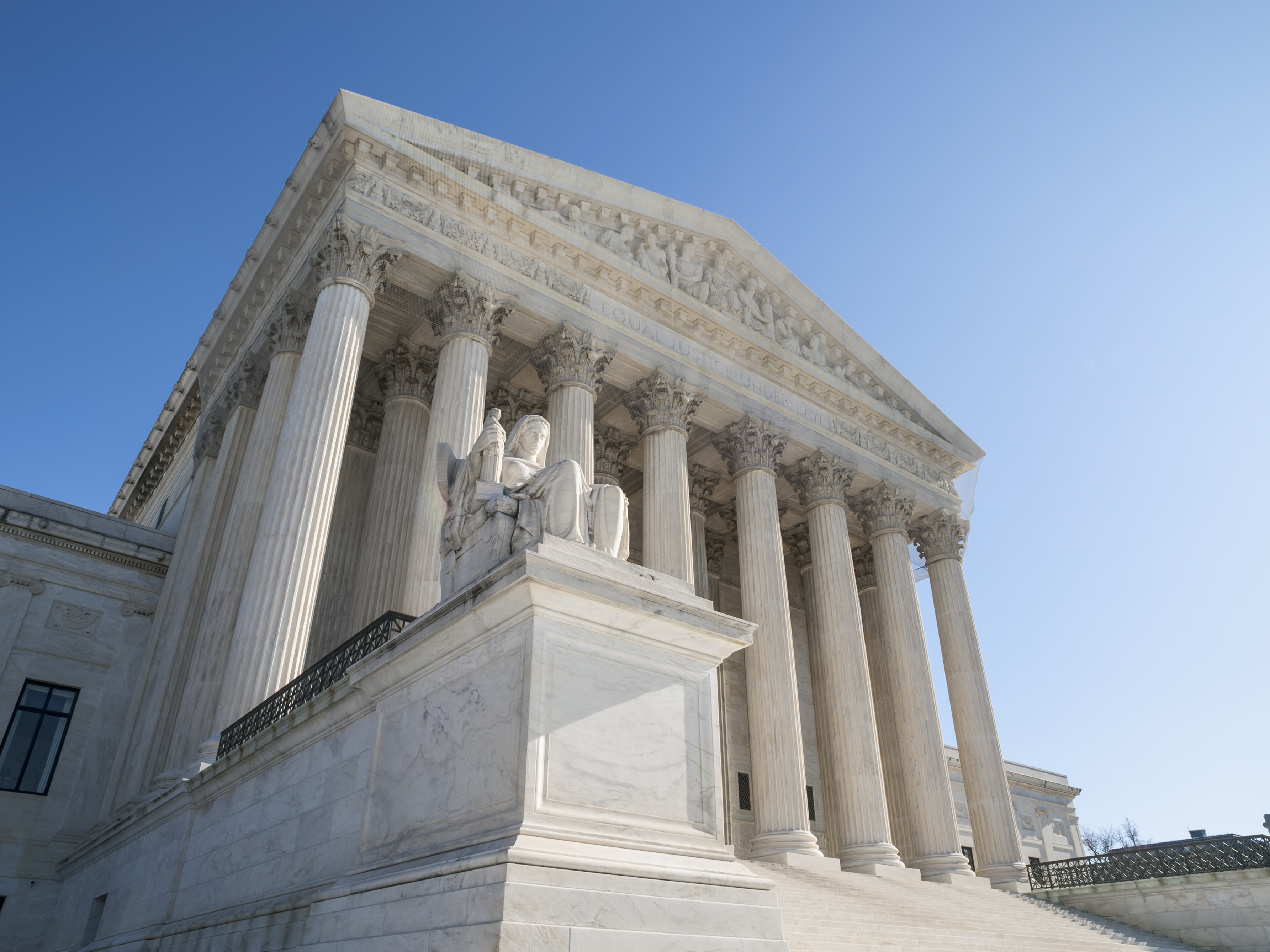
But the last time the justices considered the fate of a cross constructed on public land, Kagan was on the other side - of the bench, and of the issue.
As President Barack Obama's solicitor general, Kagan successfully defended a cross in the Mojave National Preserve, convincing the court's conservatives that what she unwaveringly referred to as a "war memorial" should remain as a tribute to the sacrifice of World War I dead.
There is a reboot of the issue facing the court Wednesday, this time with Kagan as a justice: another cross dedicated to Americans killed during World War I, a massive structure on public land in Maryland, about five miles northeast of the Supreme Court.
The legal battle over the Bladensburg Peace Cross could provide sharper definition to the court's murky jurisprudence over when religious symbols on public land violate constitutional prohibitions on government establishment of religion. It is one of the term's marquee cases, and Kagan could play a pivotal role.
It is an intriguing spot for the 58-year-old jurist, who was nominated by Obama and confirmed by the Senate in 2010 to replace retiring liberal Justice John Paul Stevens. One of four women ever to serve on the Supreme Court, Kagan is the least in the public eye. Although she is consistently on the court's left, she crosses over more often than the better-known Justices Ruth Bader Ginsburg and Sonia Sotomayor.
But she is a favorite of those who follow and practice before the court. Lawyers who argue conservative causes say she is the justice most likely to probe the weak spots of their cases. And law professors across the ideological spectrum praise her clear and often colloquial writing style.
Ginsburg, the senior justice on the left, relies on Kagan to write dissents that she and the other liberals can support, and often that happens when the disagreement is over religion.
Ginsburg, Sotomayor and Justice Stephen Breyer joined Kagan's sharp dissent when the court's conservatives recently allowed the execution of a Muslim prisoner in Alabama who was denied his request of an imam in the death chamber.
The majority's decision, which said Domineque Ray had filed his lawsuit too late in the process, was "profoundly wrong."
Under Alabama's policy, "a Christian prisoner may have a minister of his own faith accompany him into the execution chamber to say his last rites," Kagan wrote.
"But if an inmate practices a different religion - whether Islam, Judaism, or any other - he may not die with a minister of his own faith by his side. That treatment goes against the Establishment Clause's core principle of denominational neutrality."
When Kagan argued the Mojave cross case, the tables were turned. She won the support of the conservative justices and none of the liberals.
It simply may have been the case of a lawyer vigorously representing a client. Salazar v. Buono was just the second Supreme Court case Kagan argued after being confirmed as solicitor general in 2009. Told by courts that the small cross erected decades before must come down, Kagan was defending a deal Congress had made. By swapping land on which the cross stood for private property elsewhere in the preserve, the cross would be on privately held land, Kagan said, curing the constitutional problem.
"I don't know about her personal views one way of the other; I just know that she was a hard worker," said Hiram Sasser, general counsel of the conservative legal organization First Liberty, which is also involved in the current case. The group was representing Veterans of Foreign Wars, which agreed to take over upkeep of the cross, which Congress had declared an official monument to the World War I dead. Sasser was on the team of lawyers who prepared Kagan.
Dennis Schramm, at the time superintendent of the preserve, was surprised when he received a call saying Kagan was flying from Washington to visit the site. Years of litigation had preceded the Supreme Court fight, he said, and none of the other lawyers involved had made the trek to Sunrise Rock.
Kagan's preparation was mentioned in a manual for Supreme Court practitioners preparing for oral argument, and she used her familiarity with the desert during her presentation to the court. "I was out there three or four weeks ago," she said. "The superintendent drove me to the site."
Kagan told Ginsburg it would be easy to put signs on the only road leading to the cross to make clear it was on private property. And she described how the preserve was dotted with private land holdings, more than 1,000, so a visitor was never quite clear whether she was looking at government or private property.
The argument didn't persuade the court's liberals, including Stevens, the justice Kagan would later replace.
"I certainly agree that the nation should memorialize the service of those who fought and died in World War I," Stevens wrote, "but it cannot lawfully do so by continued endorsement of a starkly sectarian message."
The issue facing Kagan the justice is different from the one presented by Kagan the government lawyer. But in the small world of Supreme Court litigation, the cast is similar.
Kagan will be on the bench. Her principal deputy in the solicitor general's office, Neal Katyal, is now a private lawyer representing the Maryland-National Capital Park and Planning Commission, which owns the highway median on which the Bladensburg Peace Cross is erected. And Jeffrey Wall, who accompanied Kagan to the Mojave in 2009, is the acting solicitor general in the case.
The 40-foot Peace Cross, made of granite and cement, was built in 1925 as a tribute to men from Prince George's County, Maryland, who died during World War I. It was paid for by local families, businesses and the American Legion.
The land on which it sits was transferred in 1961 to the government commission, which pays for its maintenance and upkeep.
The cross bears a plaque listing the 49 dead; ahead of its time, it lists black and white heroes equally. VALOR; ENDURANCE; COURAGE; DEVOTION are inscribed on its four sides. At its dedication, the monument was compared with the cross of Calvary, where Jesus was crucified, and research indicates that all of the men it honors were Christians.
The American Humanist Association in 2014 challenged the constitutionality of the display of the pre-eminent symbol of Christianity on government property.
A federal district judge ruled against the organization. The Supreme Court has not ruled out historical displays of religious symbols, the judge said, adding that it met the court's test of having a secular purpose, that its "primary effect" was religious neutrality and that there was not excessive entanglement of government and religion.
The U.S. Court of Appeals for the 4th Circuit disagreed and ordered the commission to remove, relocate or redesign the memorial.
The "sectarian elements easily overwhelm the secular ones," the appeals court decided, adding that "the cross is by far the most prominent monument in the area, conspicuously displayed at a busy intersection."
Few expect the more conservative Supreme Court to agree with the 4th Circuit opinion. The question is whether it will want to decide the case narrowly, under existing precedents, or develop a new test that might give more-definitive guidance to lower courts and head off more case-by-case litigation.
Richard Garnett, an expert on religion and constitutional law at the University of Notre Dame law school, said Kagan might want to be a part of those efforts. Past votes have shown Kagan to be more of a stickler for denominational neutrality than of the strict boundaries of church and state separation that Ginsburg and Sotomayor have endorsed.
"I think Justice Kagan might want to find a place in the middle that's more than just 'we know it when we see it,' " Garnett said.
That said, Kagan has been steadfast when she thinks one religion has been favored by government over another.
She wrote a stinging dissent in 2014, when the court's conservatives found that prayers given almost entirely by Christian chaplains before meetings of the town council in Greece, New York, did not violate constitutional standards.
Kagan said the town's practice betrayed "the breathtakingly generous constitutional idea that our public institutions belong no less to the Buddhist or Hindu than to the Methodist or Episcopalian."
She suggested that there were easy ways for the town to comply with constitutional standards, and that led Justice Samuel Alito to write that Kagan's objections were, at bottom, "niggling."
She bristled. That Alito "thinks my objection to that is 'really quite niggling,' says all there is to say about the difference between our respective views," she wrote.
Sign up for the daily JWR update. It's free. Just click here.
(COMMENT, BELOW)


 Contact The Editor
Contact The Editor
 Articles By This Author
Articles By This Author